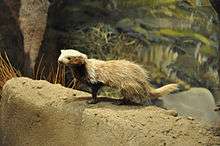Patagonian weasel
The Patagonian weasel (Lyncodon patagonicus) is a small mustelid that is the only member of the genus Lyncodon.[2] Its geographic range is the Pampas of western Argentina and sections of Chile. An early mention of the animal is in the Journal of Syms Covington, who sailed with Charles Darwin on his epic voyage aboard HMS Beagle.
| Patagonian weasel | |
|---|---|
 | |
| Mounted specimen at Museum of Patagonia | |
| Scientific classification | |
| Kingdom: | Animalia |
| Phylum: | Chordata |
| Class: | Mammalia |
| Order: | Carnivora |
| Family: | Mustelidae |
| Genus: | Lyncodon Gervais, 1845 |
| Species: | L. patagonicus |
| Binomial name | |
| Lyncodon patagonicus (Blainville, 1842) | |
| Subspecies | |
| |
 | |
| Patagonian weasel range | |
| Synonyms | |
|
Mustela patagonica Blainville, 1842 | |
Description
The Patagonian weasel has a head and body length of 300–350 mm (12–14 inches), with a tail that is 60–90 mm (2.4–3.5 inches). Its fur is whitish with black and dark brown tones mixed in. It has small ears, short legs and a bushy tail. The animal has not been thoroughly studied in the wild, and knowledge of its behavioral patterns is unsure. It reportedly has been kept as a working pet by local ranchers to destroy rodents.
References
- Kelt, D.; Pardiñas, U.; Schiaffini, M.; González-Maya, J.F. "Lyncodon patagonicus". IUCN Red List of Threatened Species. Retrieved 30 June 2016.
- Wozencraft, W.C. (2005). "Order Carnivora". In Wilson, D.E.; Reeder, D.M (eds.). Mammal Species of the World: A Taxonomic and Geographic Reference (3rd ed.). Johns Hopkins University Press. p. 608. ISBN 978-0-8018-8221-0. OCLC 62265494.
External links


- Behaviour of the Patagonian weasel
